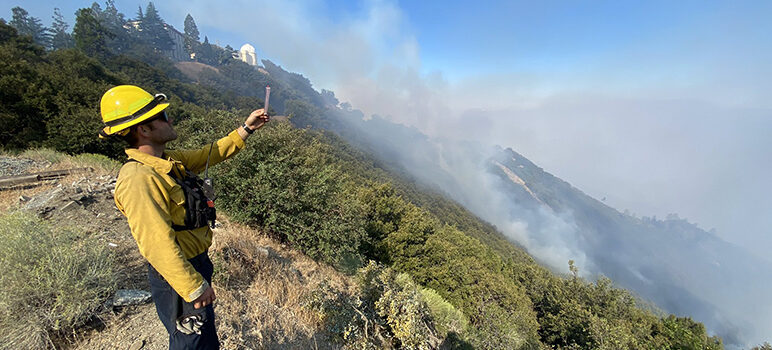Cal Fire has announced new evacuation orders for the eastern edge of Santa Clara County, where the SCU Complex fires continue to quickly spread.
As of 3pm, anyone in the following areas must leave:
- East of Shingle Valley Road and everything east of Anderson Lake and Coyote Creek
- East of Coyote Reservoir
- East of Roop, Leavesley, Crews and Ferguson roads
- East and north of Highway 152
- South of Metcalf/Shingle roads and all the way east to the Stanislaus County line
Meanwhile, evacuation warnings—which aren’t mandatory but strongly encouraged to follow—were issued for the areas listed below:
- East of Lovers Lane and the Santa Clara County line
- South of Highway 152 to the San Benito County line
- North of the San Benito County Line to Highway 152
- South of Metcalf Road and east of Coyote Creek to the Anderson Lake shore
- East of Cochrane and Hill roads
- South of Main and north of Maple avenues
- East of Foothill Avenue
- North of San Martin Avenue
- East of New Avenue
- West of Shingle Valley Road and everything west of Anderson Lake
- West of Coyote Creek and Coyote Reservoir
- North and west of Roop Road between Coyote Reservoir Road and New Avenue
KCBS Radio posted a more exhaustive list of road closures here, but the following streets are the latest to be impacted, according to Cal Fire:
- Holiday Drive at East Dunne Avenue
- Coyote Reservoir Road at Roop Road
- Canada Road at Highway 152
- Highway 152 at Belle Station
Cal Fire created a map of evacuation zones, which you can find here. The city of San Jose created an-easier-to-reference version that allows you to plug in specific addresses.
Evacuation resource centers are open at the Milpitas Library and Ann Sobrato High in Morgan Hill—the latter of which also serves as a shelter. For information about how to prepare your household for a wildfire, visit ready.gov.
#SCULightningComplex plume now. Have the radar but my the first day of my Fire Weather course starts in 30 min! pic.twitter.com/IdKmRbJzhI
— SJSU FireWeatherLab (@FireWeatherLab) August 20, 2020
Santa Clara County Animal Services is offering to help people who need a safe place to keep their pets. For information about how to access those services, which are available for people from unincorporated parts of the South Bay, call 408.686.3900.
Wag Hotels is also offering free boarding for pets of wildfire evacuees.
Wag Hotels is offering free Boarding to those affected by #wildfires in #California. We are able to provide bedding and food for #cats + #dogs. If you or someone you know is looking for a safe place to house their pets as a result of #evacuations, call 888-WAG-LINE for info pic.twitter.com/RhsrUu0BIp
— Wag Hotels (@WagHotels) August 20, 2020
An SCU August Lightning Complex incident line is up and running (albeit intermittently inaccessible because of the volume of calls) at 669.247.7431.
#SCULightningComplex #DeerFire #CanyonFire #SierraFire #ArroyoFire Firefighting resources are depleted as new fires continue to ignite. California has requested 125 fire engines from out of state firefighting agencies through the Emergency Management Assistance Compact (EMAC). pic.twitter.com/ZrdRFChFqz
— SoCal Air Operations (@SocalAirOps) August 20, 2020
Meanwhile, click here to view the latest Cal Fire updates on the SCU Complex, which was still only 5 percent contained by the latest estimate.
In a news release sent late afternoon Thursday, California Insurance Commissioner Ricardo Lara noted that residents ordered to evacuate may have homeowners’ or renters’ insurance coverage relocation costs—even if their homes survive the fires unscathed.
“With more than 367 wildfires sweeping the state, I want evacuees to know additional living expense coverage can be available to help ease the financial burden of mandatory evacuations,” Lara said in a prepared statement. “Residents who have been evacuated should contact their insurance agent or the [California] Department of Insurance to find out what their renter’s or homeowners’ policy covers and other resources that may be available to them while the mandatory evacuation orders are in place.”
Additional living expense coverage may cover food, housing, furniture rental, relocation, storage and extra transportation expenses, Lara added.
The state commissioner urged evacuees to contact their insurance company to find out if their plan covers additional living expenses and relocation costs. “It is critical to keep all receipts and document the date, time, and names of any insurance company employees you speak to regarding your coverage and details of the conversation,” he added.
Lara also offered the following tips for consumers:
- Policy provisions, including deductibles, vary by company, and residents should check with their insurance provider or agent as soon as possible to confirm coverage, limits and documentation requirements. Most renter policies also include additional living expense coverage.
- Consumers should make sure any insurance agent or public adjuster offering their services has a valid license by checking online with the Department of Insurance.
- Download the department’s Top 10 Tips for Wildfire Claimants.
- Public adjusters cannot solicit business for seven calendar days after the disaster.
- Don't forget copies of insurance policies, important papers and a photo or video inventory of your possessions. An inventory can be completed on your smart phone and safely stored in the cloud.
Meanwhile, Lara promised to look at all options to help wildfire survivors, including sponsoring Senate Bill 872 by state Sen. Bill Dodd (D-Napa), which expanses living-costs coverage in homeowners insurance after a fire emergency.

